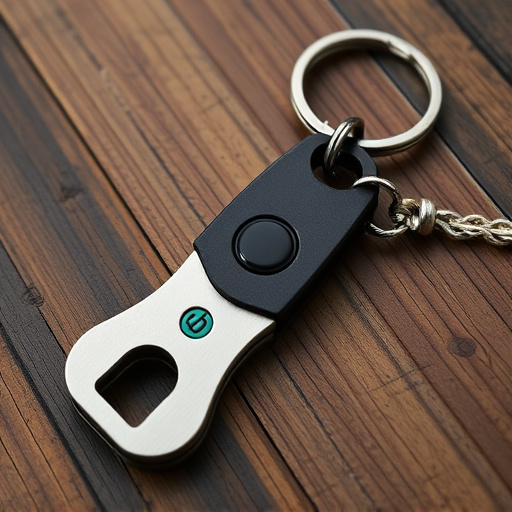In today's world, everyday carry (EDC) has evolved to prioritize personal safety, focusing on compact, versatile self-defense keychains. These tools offer sharp edges, striking surfaces, and cutting capabilities in a small form, blending discreteness with functionality. Local legalities regarding self-defense weapons are crucial; many regions permit specific non-lethal options like pepper spray and certain self-defense keychains. The ideal EDC keychain is portable, effective for deterring threats, and used responsibly within legal boundaries. It should include essential tools like bottle openers or mini flashlights, be discreet yet accessible, regularly inspected, maintained, and stored in a protective case to ensure safe and legal carrying.
“Uncover the power of tactical keychains—your everyday carry defense essential. In today’s world, being prepared for unexpected situations is paramount. This comprehensive guide explores the art of integrating permitted self-defense keychain tools into your daily routine. From understanding legal boundaries to discovering innovative features, we’ll navigate the landscape of effective self-defense mechanisms. Learn best practices and unlock the secrets to carrying a tactical keychain with confidence, ensuring you’re always prepared.”
- Understanding Tactical Keychain Tools for Everyday Carry
- Legal Considerations: Permitted Self-Defense Weapons
- Key Features and Functionality of Effective Keychain Defense Tools
- Best Practices and Tips for Carrying a Tactical Keychain Daily
Understanding Tactical Keychain Tools for Everyday Carry
In today’s world, everyday carry (EDC) has evolved beyond a simple convenience; it’s about being prepared for any situation that may arise. Permitted self-defense keychain tools are an integral part of this concept, offering compact and readily accessible means to enhance personal safety. These tactical keychains are designed with versatility in mind, featuring a combination of sharp edges, striking surfaces, and sometimes even cutting tools, all packed into a small, portable package.
The beauty of these keychain tools lies in their discreteness and functionality. They can fit comfortably on a key ring, often disguised as regular keys or accessories, making them an unobtrusive addition to your everyday carry setup. Yet, when needed, they unlock a range of possibilities for self-defense scenarios, from creating distance through a sharp pinch to delivering powerful blows with a durable striking surface. Understanding the potential of these tools is key to harnessing their effectiveness for personal safety and peace of mind.
Legal Considerations: Permitted Self-Defense Weapons
When considering a tactical keychain for everyday carry defense, it’s crucial to understand the legal considerations surrounding permitted self-defense weapons. Different jurisdictions have varying regulations on what constitutes an acceptable self-defense tool. In many places, small, non-lethal weapons like pepper spray, tasers, and certain types of keychains designed for self-defense are legally permissible. Always check local laws and regulations to ensure that the keychain you choose complies with these restrictions.
Permitted self-defense keychain tools should be compact, easy to carry, and effective in deterring or neutralizing potential threats. They must also be used responsibly and in accordance with legal guidelines, respecting the safety of both the user and others around them. Understanding your rights and obligations as a responsible citizen is essential when carrying any self-defense tool for everyday carry defense.
Key Features and Functionality of Effective Keychain Defense Tools
Effective keychain defense tools, also known as permitted self-defense keychain items, are designed to offer a discreet yet powerful means of personal safety. Key features include compactness, versatility, and reliability. These tools often incorporate multi-functional components such as a bottle opener, screwdrivers, or even sharp edges that can serve as a last resort for self-defense in unexpected situations.
Functionality is paramount; these keychains should seamlessly integrate into daily routines without drawing undue attention. They need to be easily accessible yet secure to prevent accidental deployment. The best tools strike a balance between convenience and capability, ensuring users are prepared should they encounter dangerous circumstances while on the go.
Best Practices and Tips for Carrying a Tactical Keychain Daily
When carrying a tactical keychain for everyday defense, it’s essential to prioritize safety and legality. Familiarize yourself with local laws regarding permitted self-defense keychain tools; some jurisdictions have strict regulations on the types of weapons allowed. Always keep your keychain in an accessible yet discreet location; it should be easily retrievable without drawing unnecessary attention. Regularly inspect and maintain your tactical keychain, ensuring all components are in working order. Practice proper handling techniques to avoid accidents or injuries, especially when in public spaces. Remember, the primary purpose is to provide a sense of security, not to cause alarm or engage in violence unless absolutely necessary for self-defense.
To maximize utility, consider carrying essential tools like a bottle opener, a small multi-tool, or even a mini flashlight attached to your keychain. Ensure these tools are easily reachable and securely fastened. Keep your keychain clean and dry, and store it in a protective case when not in use. By following these best practices, you can effectively carry a tactical keychain daily without compromising safety or legality.
When considering tactical keychains as everyday carry defense tools, it’s crucial to balance functionality with legal restrictions. As long as you’re aware of and adhere to local laws regarding permitted self-defense weapons, these compact tools can offer added peace of mind in various situations. Prioritizing safety and responsible carrying practices ensures that the tactical keychain becomes a valuable asset rather than a liability. Remember, proper training and understanding your surroundings are essential for effective deployment.
